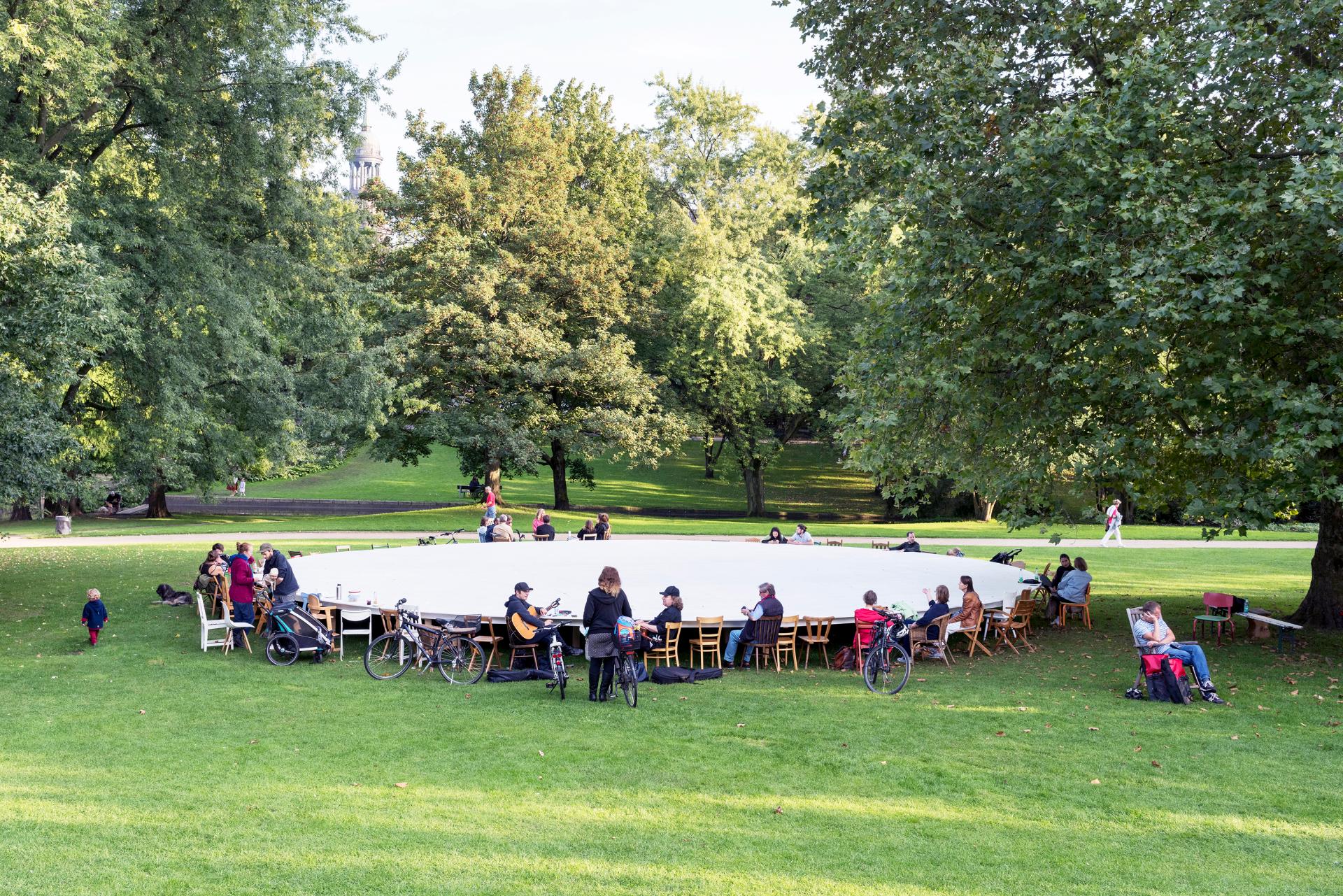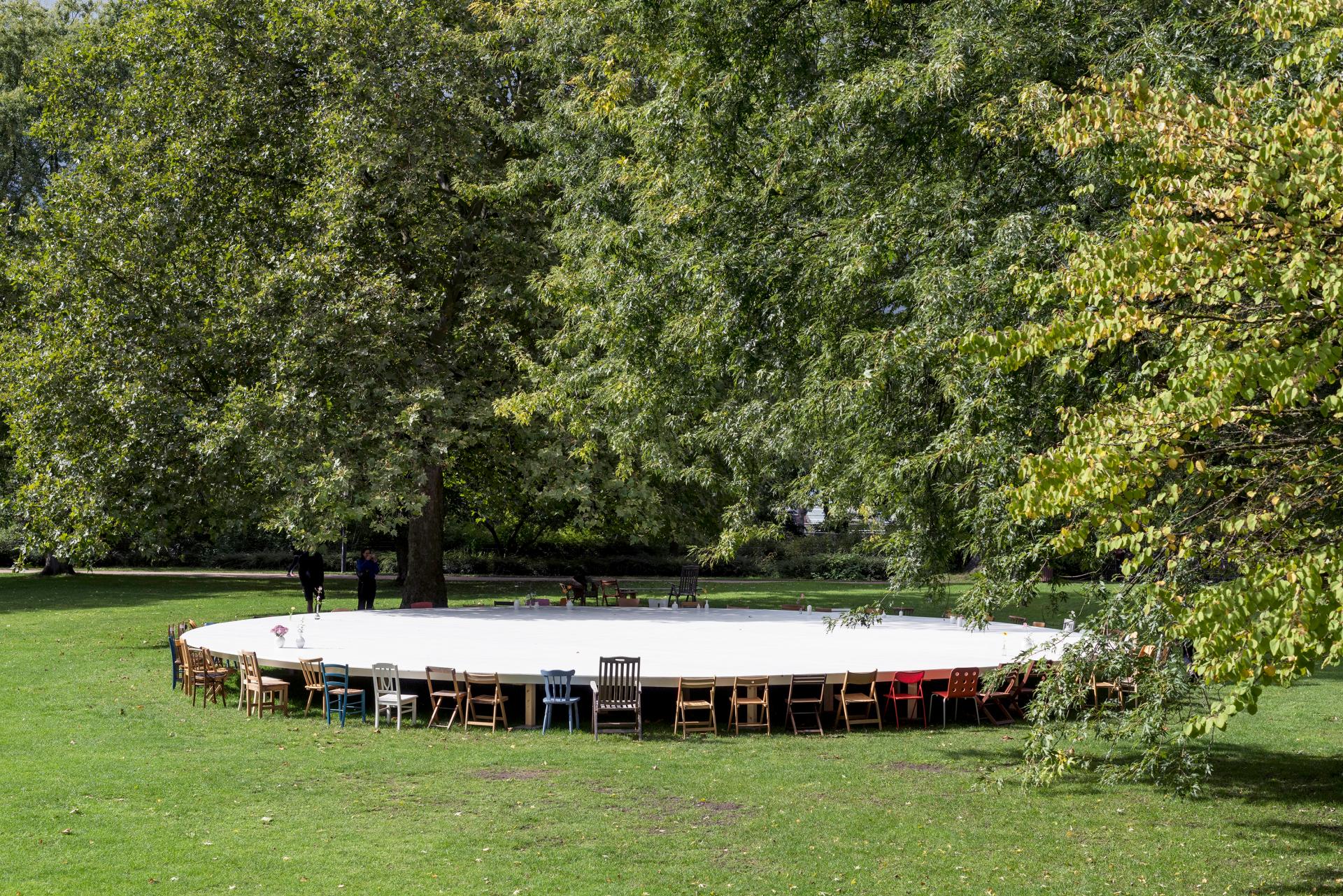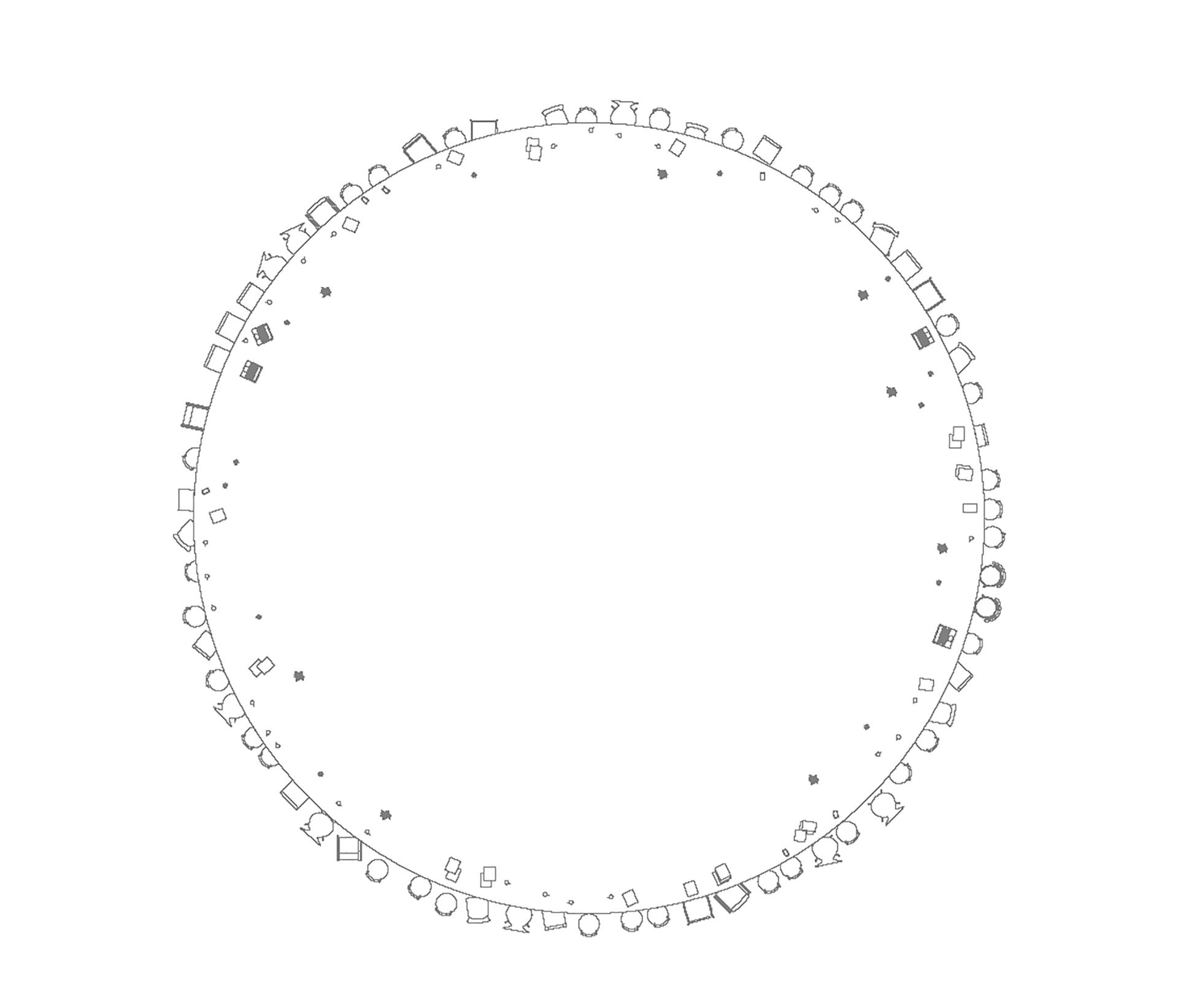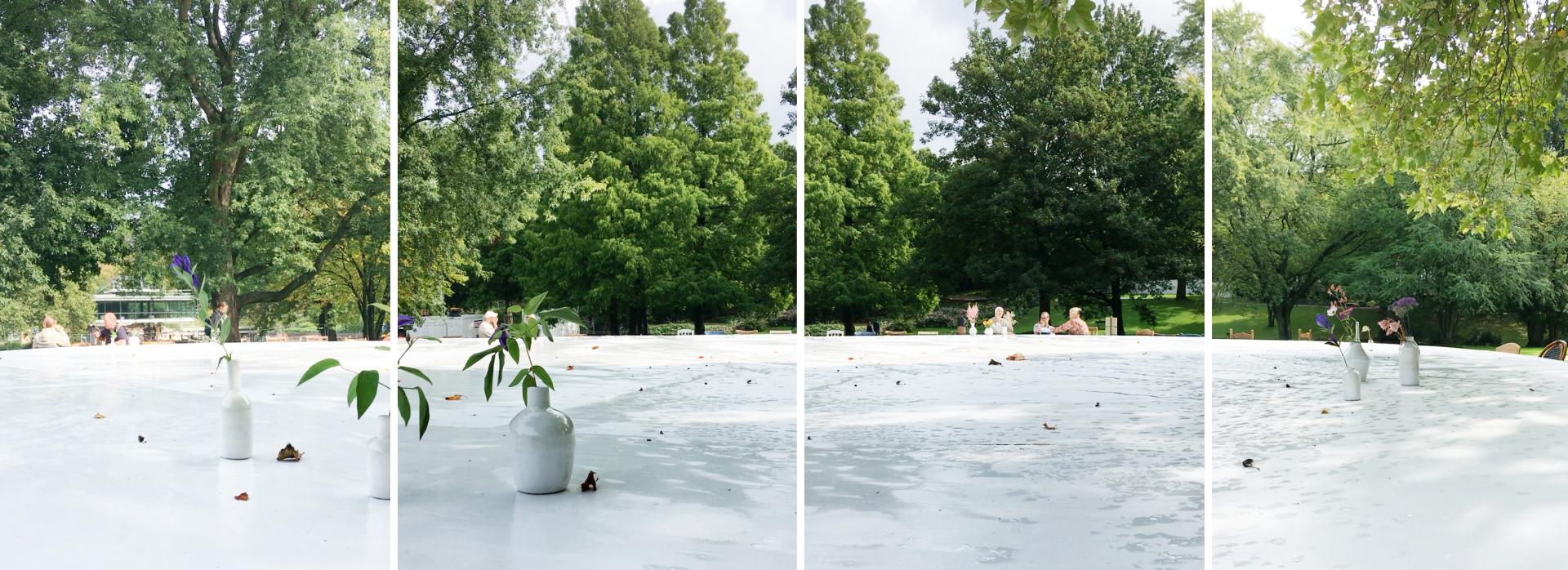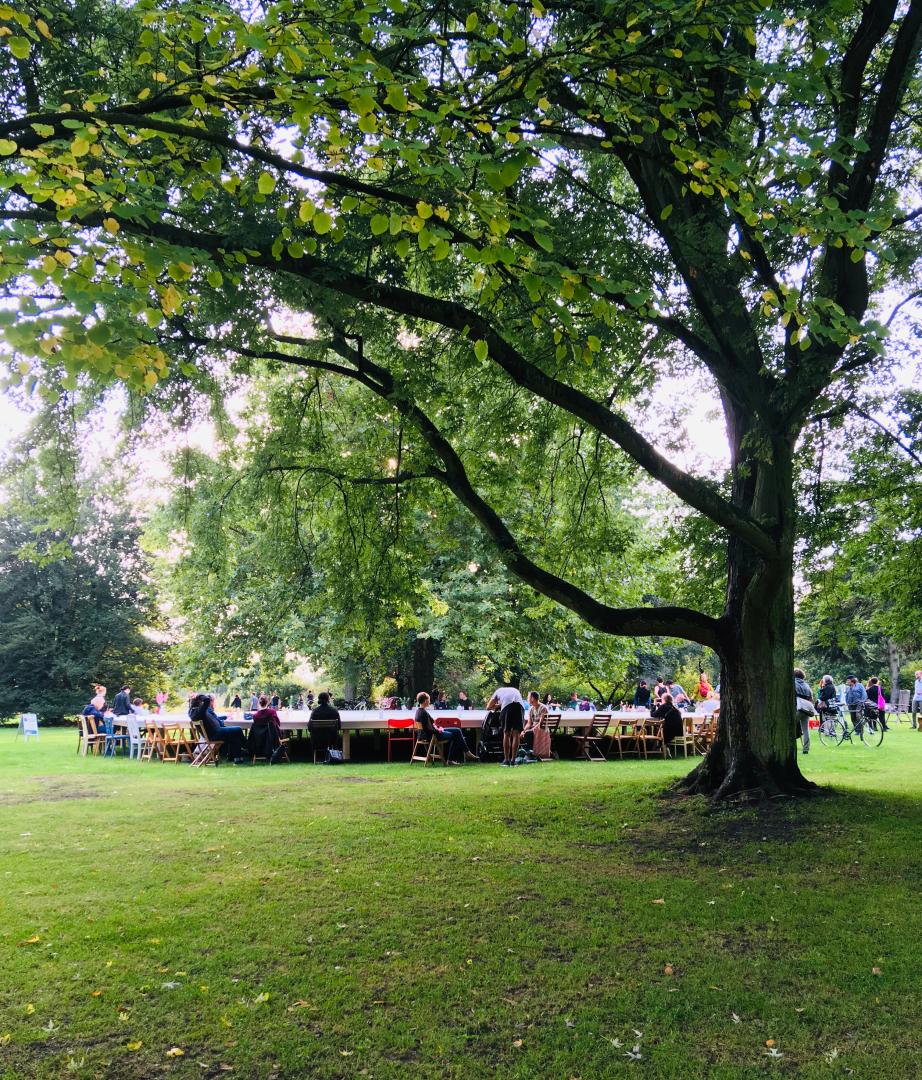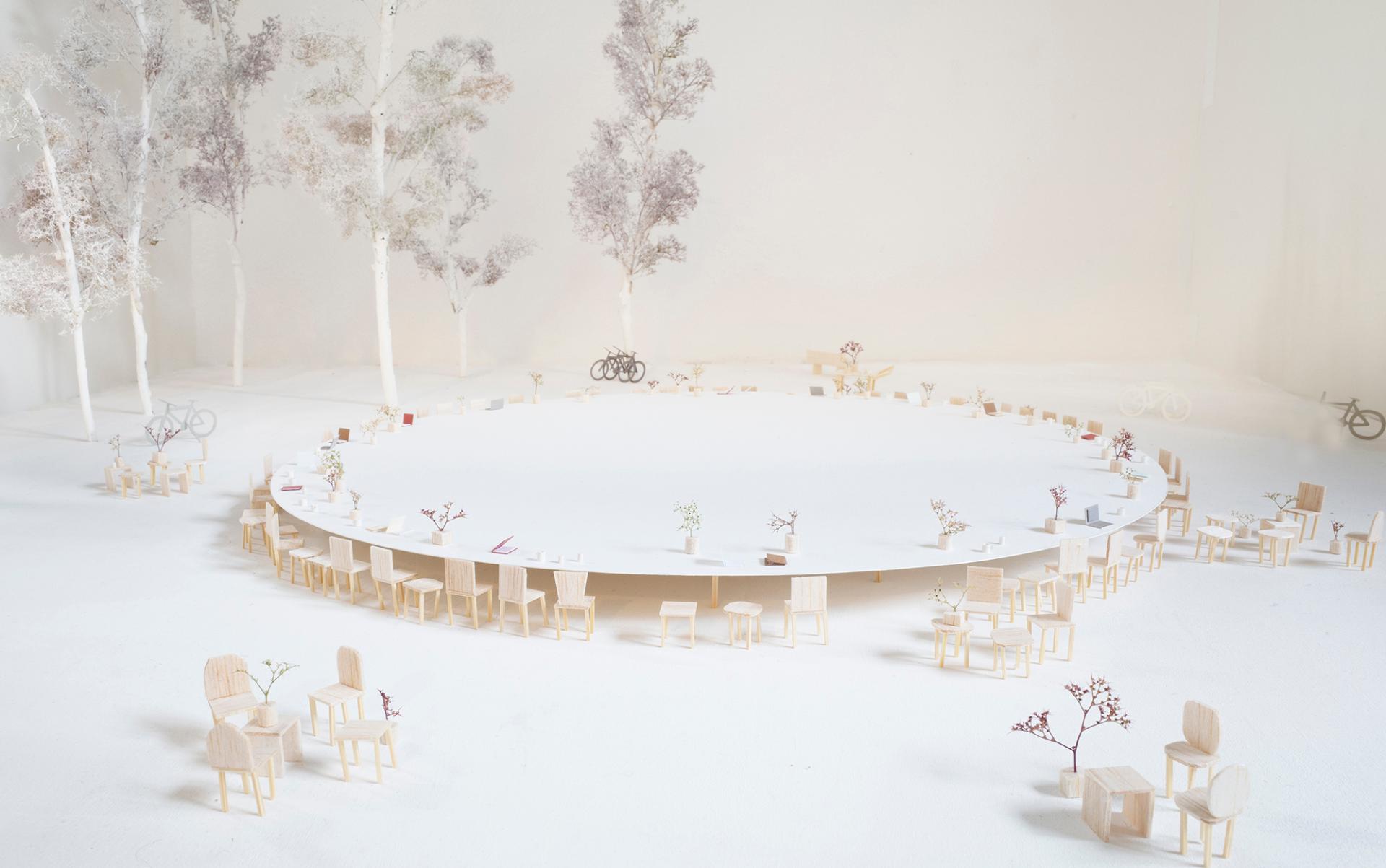Where people meet people
Basic information
Project Title
Where people meet people
Full project title
Where people meet people
Category
Prioritising the places and people that need it the most
Project Description
This is a large, round table with a diameter of 15m. A table where people meet people. A self-initiated temporary project. During Covid 19, I spent a lot of time alone. Sometimes I didn’t talk to anyone for 2-3 days. I didn’t realise how “important” it is to meet people. We often notice something important and beautiful first when we lose it. Then, I dreamed of getting together without any obligations. I dreamed of a place with the possibility of encounters. A place for everyone.
Geographical Scope
Local
Project Region
Hamburg , Germany
Urban or rural issues
Mainly urban
Physical or other transformations
It refers to a physical transformation of the built environment (hard investment)
EU Programme or fund
No
Description of the project
Summary
1: Where people meet people
This is a large, round table with a diameter of 15m. A table where people meet people. This project is a temporary (10 days in September 2021), participatory installation which was initiated by myself, and it was realized in Planten un Blomen in Hamburg with a grant from the Free and Hanseatic City of Hamburg, Authority for Culture and Media.
2: Background
In 2020, I spent a lot of time alone because of the corona pandemic. Sometimes I didn't talk to anyone for 2-3 days. I used to think I was pretty good at being alone, but this time I honestly missed my friends and family. I didn't realize how “important” it was to simply meet people. I don't think I'm the only one who has experienced this process. We often don't notice something beautiful until we've lost it.
3: Target groups and objectives
When it was difficult to meet people, I dreamed of getting together without any obligations. I dreamed of a place with the possibility of encounters. A place for everyone. I aimed to create an installation that everyone could participate in, not only those who are involved in art, but also people who don't normally go to exhibitions, including people of all ages and genders.
Many people have suffered from mental problems because of too much time alone, therefore the objective of the project was to offer a place where you can share a space and time with others. My challenge was also to show a positive message by realizing this symbolic project.
4: What this project achieved and what people needed it
Many people have taken a seat at the large table. They chatted with other people, ate, drank, took selfies, sat alone and also worked. The table attracted people like a magnet. This installation was experienced by literally all kinds of people, including people in the art world, people who found the project on the internet, and people who happened to find it.
This is a large, round table with a diameter of 15m. A table where people meet people. This project is a temporary (10 days in September 2021), participatory installation which was initiated by myself, and it was realized in Planten un Blomen in Hamburg with a grant from the Free and Hanseatic City of Hamburg, Authority for Culture and Media.
2: Background
In 2020, I spent a lot of time alone because of the corona pandemic. Sometimes I didn't talk to anyone for 2-3 days. I used to think I was pretty good at being alone, but this time I honestly missed my friends and family. I didn't realize how “important” it was to simply meet people. I don't think I'm the only one who has experienced this process. We often don't notice something beautiful until we've lost it.
3: Target groups and objectives
When it was difficult to meet people, I dreamed of getting together without any obligations. I dreamed of a place with the possibility of encounters. A place for everyone. I aimed to create an installation that everyone could participate in, not only those who are involved in art, but also people who don't normally go to exhibitions, including people of all ages and genders.
Many people have suffered from mental problems because of too much time alone, therefore the objective of the project was to offer a place where you can share a space and time with others. My challenge was also to show a positive message by realizing this symbolic project.
4: What this project achieved and what people needed it
Many people have taken a seat at the large table. They chatted with other people, ate, drank, took selfies, sat alone and also worked. The table attracted people like a magnet. This installation was experienced by literally all kinds of people, including people in the art world, people who found the project on the internet, and people who happened to find it.
Key objectives for sustainability
1: Chairs
Almost all of the chairs used in this installation were donated. Chairs that were no longer used at home or that had been left in the attic or garage were used. In order to collect approximately 60 chairs, I wrote many Emails and used SNS. It made it possible to have contacts not only with friends but also with people whom I didn't know. Many people beyond my friends cooperated in this way for this project. After the installation was finished, some of the chairs were returned to their original owners, while others were given to new owners. All of the chairs could be reused, except for the ones that were broken and became difficult to use.
2: Tabel
This large table is made entirely of wood except for the metal fittings at the joints. After the installation, the table was dismantled and the materials were taken over by the carpenter team. Some materials were used for making small tables, others were used for different projects. Although it was difficult to re-use all the material, partially because of the rain during the installation period, the carpenter team attempted to re-use the materials as much as possible.
Almost all of the chairs used in this installation were donated. Chairs that were no longer used at home or that had been left in the attic or garage were used. In order to collect approximately 60 chairs, I wrote many Emails and used SNS. It made it possible to have contacts not only with friends but also with people whom I didn't know. Many people beyond my friends cooperated in this way for this project. After the installation was finished, some of the chairs were returned to their original owners, while others were given to new owners. All of the chairs could be reused, except for the ones that were broken and became difficult to use.
2: Tabel
This large table is made entirely of wood except for the metal fittings at the joints. After the installation, the table was dismantled and the materials were taken over by the carpenter team. Some materials were used for making small tables, others were used for different projects. Although it was difficult to re-use all the material, partially because of the rain during the installation period, the carpenter team attempted to re-use the materials as much as possible.
Key objectives for aesthetics and quality
1: Key objective
As mentioned before, the goal of this project is to create a space for everyone, "where people meet people". For this purpose, the question of what kind of design would be best was considered during the project process.
2: Why a table
Dining tables have multiple functions than just being a place to eat. For many families it is a get-together after a day at school or work. My mother used to drink tea at the table in our house with her friends while I did my homework, for example. Every now and then she looked over to see if I was doing everything right. In this way I could listen to their conversations. The table was large enough to accommodate our various activities. At the same time, the table was small enough to establish indirect communication between us.
3: Experience
Because of its size and shape, there was sometimes a great distance from someone sitting on the other side: in the middle of the table there was a large empty space. People sat around the table “face to face.” They stared at the center of the table. Despite the great distance, the table allowed people to meet other people: it enabled encounters between people.
The table did not serve as an art venue. People could drink coffee there, read, talk to each other or simply stay alone. The table was accessible to everyone like a bench in a park. It was very informal, and open.
As mentioned before, the goal of this project is to create a space for everyone, "where people meet people". For this purpose, the question of what kind of design would be best was considered during the project process.
2: Why a table
Dining tables have multiple functions than just being a place to eat. For many families it is a get-together after a day at school or work. My mother used to drink tea at the table in our house with her friends while I did my homework, for example. Every now and then she looked over to see if I was doing everything right. In this way I could listen to their conversations. The table was large enough to accommodate our various activities. At the same time, the table was small enough to establish indirect communication between us.
3: Experience
Because of its size and shape, there was sometimes a great distance from someone sitting on the other side: in the middle of the table there was a large empty space. People sat around the table “face to face.” They stared at the center of the table. Despite the great distance, the table allowed people to meet other people: it enabled encounters between people.
The table did not serve as an art venue. People could drink coffee there, read, talk to each other or simply stay alone. The table was accessible to everyone like a bench in a park. It was very informal, and open.
Key objectives for inclusion
1: My concern and objective
When you are in the "art world", you realize that it is very small. There aren't that many people who are interested in art and regularly visit museums or galleries. Being seen by many people isn't the only good thing, and I think it's perfectly normal for people with different tastes to form a kind of "separation".
However, one of the goals of this installation for me was to create a project literally for everyone at the time when the barriers and distance between people have deepened.
2: What I did and what this project achieved
Two things were important for this purpose mentioned above. The first was installing this installation in Planten un Blomen, a public park located in the center of Hamburg that attracts a large number of visitors. There are many entrances to this park, and they are used not only by people who use the park, but also as passageways in a sense. You'll find all kinds of people, from young joggers to elderly people strolling, fathers and mothers with prams, and more.
The second point may be very mundane, but I think it was important that I did not impose admission fees. I think that "not taking money'' was an important factor in ensuring that people who happened to stumble upon this installation could sit down and feel as casual as a bench in a park, as I mentioned earlier. Perhaps as a result of this, some people came back again and again, and even a teacher with a group of kindergarten children stopped by.
This project was very easy to access in a physical way and also demanded no financial effort. That made this installation truly accessible.
When you are in the "art world", you realize that it is very small. There aren't that many people who are interested in art and regularly visit museums or galleries. Being seen by many people isn't the only good thing, and I think it's perfectly normal for people with different tastes to form a kind of "separation".
However, one of the goals of this installation for me was to create a project literally for everyone at the time when the barriers and distance between people have deepened.
2: What I did and what this project achieved
Two things were important for this purpose mentioned above. The first was installing this installation in Planten un Blomen, a public park located in the center of Hamburg that attracts a large number of visitors. There are many entrances to this park, and they are used not only by people who use the park, but also as passageways in a sense. You'll find all kinds of people, from young joggers to elderly people strolling, fathers and mothers with prams, and more.
The second point may be very mundane, but I think it was important that I did not impose admission fees. I think that "not taking money'' was an important factor in ensuring that people who happened to stumble upon this installation could sit down and feel as casual as a bench in a park, as I mentioned earlier. Perhaps as a result of this, some people came back again and again, and even a teacher with a group of kindergarten children stopped by.
This project was very easy to access in a physical way and also demanded no financial effort. That made this installation truly accessible.
Results in relation to category
I didn't count the number or take a survey, so I can only write my impressions. But many people sat around this table during the 10-day installation held in September 2021. It was a project that was very well received. Some people come back again and again, even when it rained. Also, as mentioned before, it was very meaningful to be able to give this project a chance to be experienced by people who are not normally interested in art, such as people who happened to find this installation, and people who came because their friends recommended it.
I have to repeat again what I already mentioned. It says a lot about what this project achieved that I received "Thank you for making this installation" not only once but many times from the people sitting around this round table. At that time, I felt that I was able to "communicate" with society through my work as an artist.
I have to repeat again what I already mentioned. It says a lot about what this project achieved that I received "Thank you for making this installation" not only once but many times from the people sitting around this round table. At that time, I felt that I was able to "communicate" with society through my work as an artist.
How Citizens benefit
1: What people needed
This project was implemented during the coronavirus pandemic (more precisely, when the coronavirus situation was gradually improving). At that time, I think that many people including myself realized how important it was to meet people, and conversely, how big and negative the impact of this situation was, in which you were not able to meet people. As mentioned before, during this installation period, many people approached me and said, "Thank you for doing this project." As with the experience of actually sitting around this table, I feel that people have received the message that this symbolic form was conveying.
2: A project that everyone can participate
There were not that many people who have been involved in this project in a narrow sense, such as those who were involved in the production of the table. However, I consider this installation to be participatory, and I believe that it was a project that can only be completed when someone was sitting around the table. When we hear the word "Involvement", we tend to think of it as some kind of work, but I think it was a project completed by a mix of the artist, participants, users, and viewers. In that sense, there were a large number of people involved in the project, and they played a major role.
This project was implemented during the coronavirus pandemic (more precisely, when the coronavirus situation was gradually improving). At that time, I think that many people including myself realized how important it was to meet people, and conversely, how big and negative the impact of this situation was, in which you were not able to meet people. As mentioned before, during this installation period, many people approached me and said, "Thank you for doing this project." As with the experience of actually sitting around this table, I feel that people have received the message that this symbolic form was conveying.
2: A project that everyone can participate
There were not that many people who have been involved in this project in a narrow sense, such as those who were involved in the production of the table. However, I consider this installation to be participatory, and I believe that it was a project that can only be completed when someone was sitting around the table. When we hear the word "Involvement", we tend to think of it as some kind of work, but I think it was a project completed by a mix of the artist, participants, users, and viewers. In that sense, there were a large number of people involved in the project, and they played a major role.
Physical or other transformations
It refers to a physical transformation of the built environment (hard investment)
Innovative character
1: A project that everyone can participate in
You might say that many art projects are difficult to approach. Particularly in contemporary art, there are many works and projects that are difficult to understand without prior knowledge. This may be a rough summary, however while there are many projects like this, I aimed for a project that anyone could "easily" experience. Although this project is not innovative in a technical sense, I think it can be differentiated from many other projects in the sense of opening up art projects to wider audiences.
2: Table as an art project
If I were to describe this installation very simply, it would be "a large round table in a park." The activities that take place there are no different from those that take place around an ordinary table, such as talking with friends, drinking coffee, reading a book, and eating a meal. The only difference is that it is extremely large. This changes the way we see something ordinary. This is an art installation but also a piece of furniture. This installation may be able to differentiate itself also in terms of distance between art and everyday life.
You might say that many art projects are difficult to approach. Particularly in contemporary art, there are many works and projects that are difficult to understand without prior knowledge. This may be a rough summary, however while there are many projects like this, I aimed for a project that anyone could "easily" experience. Although this project is not innovative in a technical sense, I think it can be differentiated from many other projects in the sense of opening up art projects to wider audiences.
2: Table as an art project
If I were to describe this installation very simply, it would be "a large round table in a park." The activities that take place there are no different from those that take place around an ordinary table, such as talking with friends, drinking coffee, reading a book, and eating a meal. The only difference is that it is extremely large. This changes the way we see something ordinary. This is an art installation but also a piece of furniture. This installation may be able to differentiate itself also in terms of distance between art and everyday life.
Disciplines/knowledge reflected
1: Architecture and Art
I work as an artist and an architect and both of these professions worked well together for this project. During the coronavirus pandemic, I faced mental problems and tried to understand how other people were. Because it affected me a lot, I attempted to sublimate my problem into a work of art. And this is the approach which I often use for my art project: Starting from my personal issues.
My professional skills as an architect played a big role, too, in implementing the project. Drawing technical plans made it easy for me to communicate with authority offices, structural engineers and carpenters. Ideas were influenced by realistic constraints, these constraints made, however, the ideas even better. This process is exactly what applies to my profession as an architect.
In this sense, the idea for this installation was born and realized by the combination of these two professional skills and experience within me.
2: Collaboration with carpenters
The project was realized in collaboration with a team of carpenters called ATiC Interior in Hamburg. The idea of reusing the materials after this table-installation came from the director of this office. They were responsible for all the actual processes such as cutting, assembling, and disassembling. I was also able to have a conceptual-level discussion with this director, who has a background in design, such as what is necessary and what is not necessary for this large table to look like a table.
3: Collaboration with another artist
This large round table was decorated with flowers and plants in ceramic vases. These ceramic vases were created specifically for this installation by an artist in Hamburg. Her works, which show the traces of her hands, served as a nice accent to the round table, which has a very strong geometric shape. As an idea from her, the plants from the park were used. This idea strengthened the connection between the installation and the park.
I work as an artist and an architect and both of these professions worked well together for this project. During the coronavirus pandemic, I faced mental problems and tried to understand how other people were. Because it affected me a lot, I attempted to sublimate my problem into a work of art. And this is the approach which I often use for my art project: Starting from my personal issues.
My professional skills as an architect played a big role, too, in implementing the project. Drawing technical plans made it easy for me to communicate with authority offices, structural engineers and carpenters. Ideas were influenced by realistic constraints, these constraints made, however, the ideas even better. This process is exactly what applies to my profession as an architect.
In this sense, the idea for this installation was born and realized by the combination of these two professional skills and experience within me.
2: Collaboration with carpenters
The project was realized in collaboration with a team of carpenters called ATiC Interior in Hamburg. The idea of reusing the materials after this table-installation came from the director of this office. They were responsible for all the actual processes such as cutting, assembling, and disassembling. I was also able to have a conceptual-level discussion with this director, who has a background in design, such as what is necessary and what is not necessary for this large table to look like a table.
3: Collaboration with another artist
This large round table was decorated with flowers and plants in ceramic vases. These ceramic vases were created specifically for this installation by an artist in Hamburg. Her works, which show the traces of her hands, served as a nice accent to the round table, which has a very strong geometric shape. As an idea from her, the plants from the park were used. This idea strengthened the connection between the installation and the park.
Methodology used
1: Starting with my own problems
In the first phase of the project, my own experience with "loneliness" played a big role. In a way I tried to objectify my feelings into a work of art/installation. Here, I would like to state my "approach" by describing what kind of thinking process I went through to come up with the idea for this project.
2: Time of solitude and loneliness
As already mentioned, through the coronavirus pandemic, I have come to realize the importance of "meeting people". I also learned that not being able to meet people for long time can be a major factor in losing one's mental balance. That is, "meeting people" is very essential for us. That was the motivation to start this installation.
3: Imagining others
In order to avoid making my work too "personal," I started thinking about what other people's experiences were with "meeting people." I wondered if I'm the only one who felt lonely, but as I talked with friends and watched the news, I realized that loneliness during the coronavirus pandemic is a more common problem. Therefore, if I develop my work based on my honest feelings and experiences, I might be able to find a contact point with other people or with society. That was the next step in my thought.
4: The frustration of being an artist
During the coronavirus pandemic, essential workers, people whose jobs are "necessary" to society, have received a lot of attention. While I have had nothing but respect for their works, I have always wondered if I could do anything for someone. As an artist and an architect, was there anything I could do to contribute to society? This thought was the basis for the idea of "place for everyone."
In the first phase of the project, my own experience with "loneliness" played a big role. In a way I tried to objectify my feelings into a work of art/installation. Here, I would like to state my "approach" by describing what kind of thinking process I went through to come up with the idea for this project.
2: Time of solitude and loneliness
As already mentioned, through the coronavirus pandemic, I have come to realize the importance of "meeting people". I also learned that not being able to meet people for long time can be a major factor in losing one's mental balance. That is, "meeting people" is very essential for us. That was the motivation to start this installation.
3: Imagining others
In order to avoid making my work too "personal," I started thinking about what other people's experiences were with "meeting people." I wondered if I'm the only one who felt lonely, but as I talked with friends and watched the news, I realized that loneliness during the coronavirus pandemic is a more common problem. Therefore, if I develop my work based on my honest feelings and experiences, I might be able to find a contact point with other people or with society. That was the next step in my thought.
4: The frustration of being an artist
During the coronavirus pandemic, essential workers, people whose jobs are "necessary" to society, have received a lot of attention. While I have had nothing but respect for their works, I have always wondered if I could do anything for someone. As an artist and an architect, was there anything I could do to contribute to society? This thought was the basis for the idea of "place for everyone."
How stakeholders are engaged
1. Project funded by Hamburg
This project was realised with funds from Hamburg. The “Art in Public Spaces” funding program has existed since 1981 and artists have had the opportunity to apply to the Authority for Culture and Media with proposals for projects in public spaces. For my project this time, I received support for the entire amount of funds needed for the project, approximately 23,000 euros. After that, there was no special involvement from the authority in the implementation of the project. I think this is a great funding program to support artists.
2: Project location: Planten un Blomen
The office of Punten un Blomen, a park in the center of Hamburg, was very cooperative. This park is very large and there were several possible locations for my installation. They know the different situations in the park and gave me very useful advice on safety, accessibility, and other issues, when I decided the exact location of the project. Also, during the installation period, they often visited the installation site and asked me if everything was going smoothly. I had the impression that the park office took care of the installation together and supported me in various ways. I am still very grateful for their support.
I learned also that cooperation and support from the project site side and authority was necessary to do a successful project.
This project was realised with funds from Hamburg. The “Art in Public Spaces” funding program has existed since 1981 and artists have had the opportunity to apply to the Authority for Culture and Media with proposals for projects in public spaces. For my project this time, I received support for the entire amount of funds needed for the project, approximately 23,000 euros. After that, there was no special involvement from the authority in the implementation of the project. I think this is a great funding program to support artists.
2: Project location: Planten un Blomen
The office of Punten un Blomen, a park in the center of Hamburg, was very cooperative. This park is very large and there were several possible locations for my installation. They know the different situations in the park and gave me very useful advice on safety, accessibility, and other issues, when I decided the exact location of the project. Also, during the installation period, they often visited the installation site and asked me if everything was going smoothly. I had the impression that the park office took care of the installation together and supported me in various ways. I am still very grateful for their support.
I learned also that cooperation and support from the project site side and authority was necessary to do a successful project.
Global challenges
Here I would like to repeat what I wrote in the previous section with different wordings.
First of all, due to its nature as an art project, I don't think this installation is suitable for providing solutions to anything. Rather, I think what an art project can do is provoke (already asked) questions (again). With that in mind, I would like to think about what the global challenges are. Global challenges may change from time to time. The coronavirus pandemic has forced people around the world to adjust their lifestyles, and this has brought about many benefits and problems. For example, many people have reconsidered the need to move/travel. The installation I made in 2021, "Where people meet people," had as its theme the time and place of"meeting people," which were important for many people too. Although it was realized in Hamburg, Germany, I started creating the work based on what was happening all over the world, what the project could show was this global and universal theme.
In this sense, if I had the opportunity to realize this project again now, what this installation could address would be something different.
First of all, due to its nature as an art project, I don't think this installation is suitable for providing solutions to anything. Rather, I think what an art project can do is provoke (already asked) questions (again). With that in mind, I would like to think about what the global challenges are. Global challenges may change from time to time. The coronavirus pandemic has forced people around the world to adjust their lifestyles, and this has brought about many benefits and problems. For example, many people have reconsidered the need to move/travel. The installation I made in 2021, "Where people meet people," had as its theme the time and place of"meeting people," which were important for many people too. Although it was realized in Hamburg, Germany, I started creating the work based on what was happening all over the world, what the project could show was this global and universal theme.
In this sense, if I had the opportunity to realize this project again now, what this installation could address would be something different.
Learning transferred to other parties
1: Universality of theme and simplicity of idea
This project is highly repricatable in two respects. First, the theme is very universal. It is easy to imagine that the theme of "meeting people" has different nuances depending on the country and society, but it is a theme that can be shared by everyone. In other words, it is a very universal theme in that it goes beyond a social theme and becomes a theme of humanity.
Secondly, it's not that difficult in a technical sense to replicate this installation. Even though you should not forget about economic and safety aspects such as the amount of materials required and the characteristics of the space, it would be relatively easy to do this project again if you could have a certain amount of money and a suitable location.
2: Meaning of the project in social context
In 2021, when I realized this project, although the worst situation due to the coronavirus had subsided and life was gradually starting to return to "normal", it was still a time when we could feel the aftermath of the pandemic. That's why the major theme of this project, "meeting people," was brought to light. As of 2023, the confusion and situation caused by the coronavirus has almost disappeared, but in a different sense, society is still not calm. I won't go into specifics here, but I think there are "conflicts" in various meanings all over the world and everywhere. I have been wondering what we need now is "dialogue" without hierarchy. In that sense, this project could bring the spirit of the time to light again. Therefore I believe that there is some significance in carrying out this project again.
This project is highly repricatable in two respects. First, the theme is very universal. It is easy to imagine that the theme of "meeting people" has different nuances depending on the country and society, but it is a theme that can be shared by everyone. In other words, it is a very universal theme in that it goes beyond a social theme and becomes a theme of humanity.
Secondly, it's not that difficult in a technical sense to replicate this installation. Even though you should not forget about economic and safety aspects such as the amount of materials required and the characteristics of the space, it would be relatively easy to do this project again if you could have a certain amount of money and a suitable location.
2: Meaning of the project in social context
In 2021, when I realized this project, although the worst situation due to the coronavirus had subsided and life was gradually starting to return to "normal", it was still a time when we could feel the aftermath of the pandemic. That's why the major theme of this project, "meeting people," was brought to light. As of 2023, the confusion and situation caused by the coronavirus has almost disappeared, but in a different sense, society is still not calm. I won't go into specifics here, but I think there are "conflicts" in various meanings all over the world and everywhere. I have been wondering what we need now is "dialogue" without hierarchy. In that sense, this project could bring the spirit of the time to light again. Therefore I believe that there is some significance in carrying out this project again.
Keywords
Meeting
Encounter
Open to everyone
Corporate feeling
Sharing time and place

